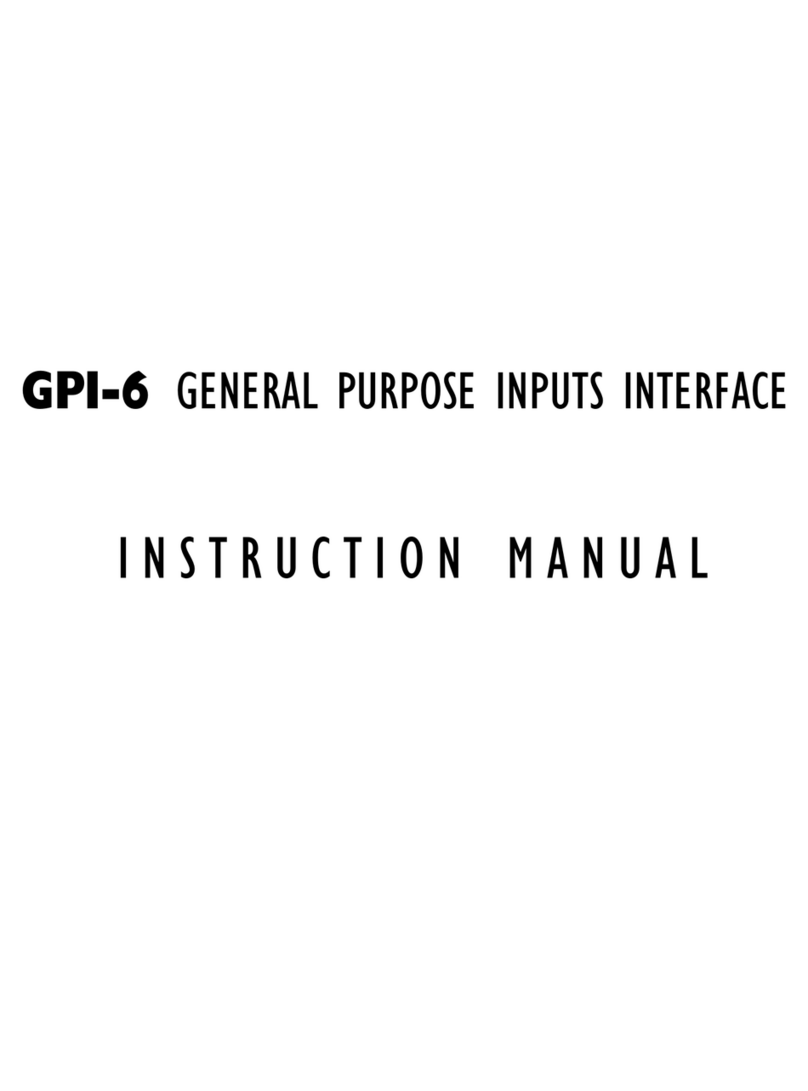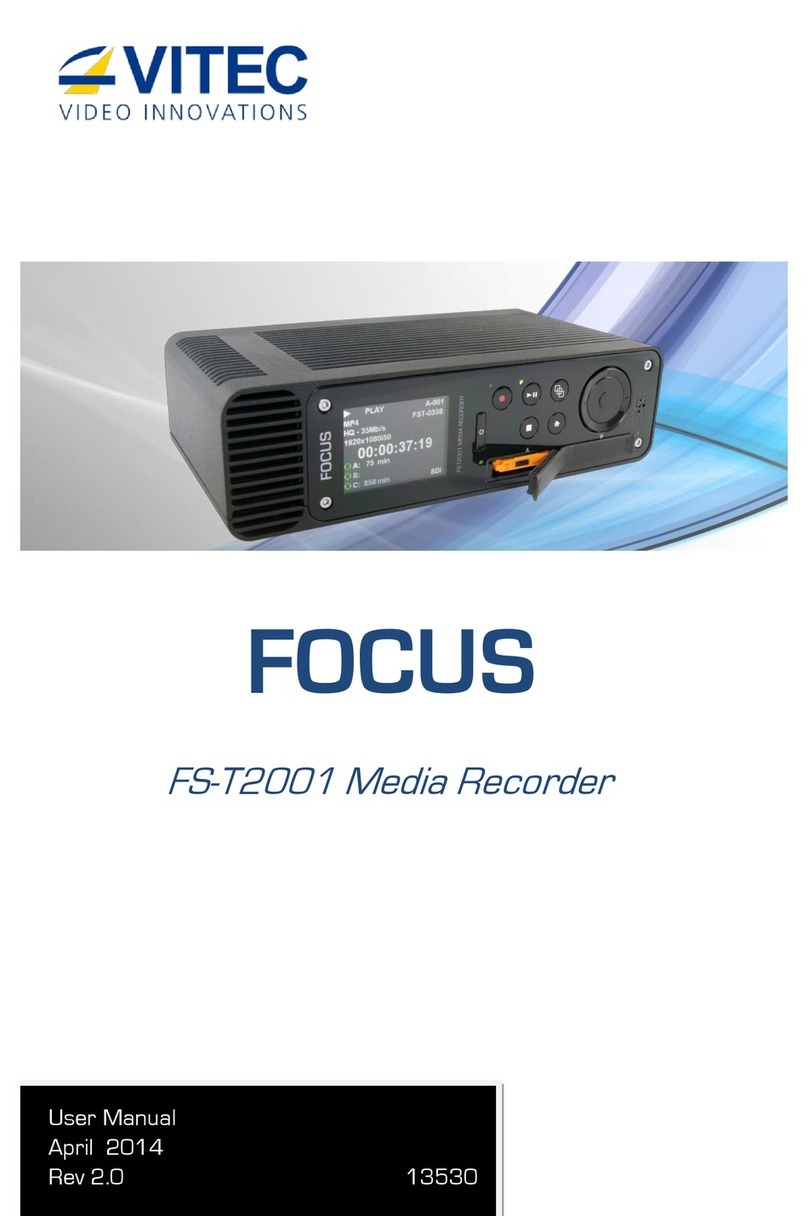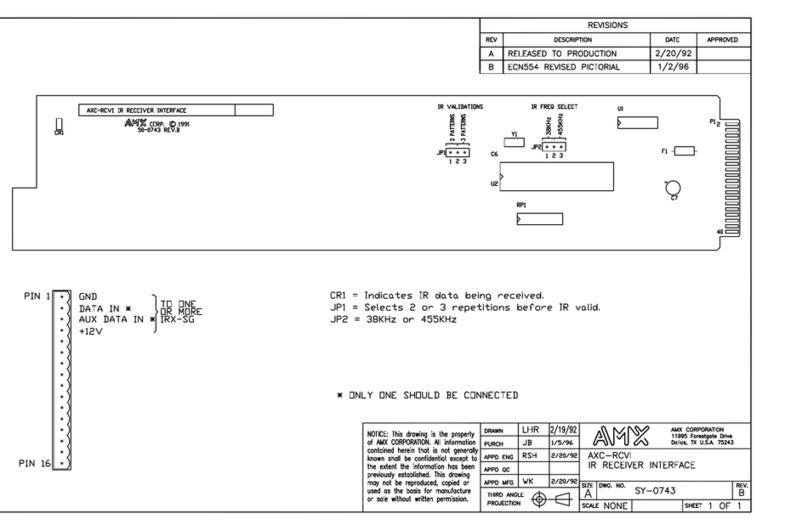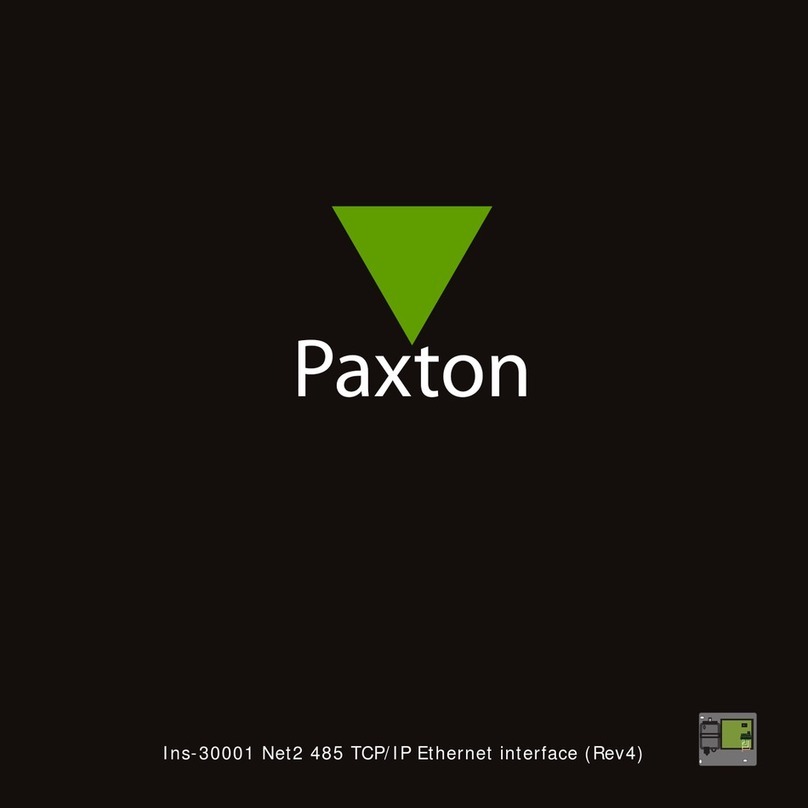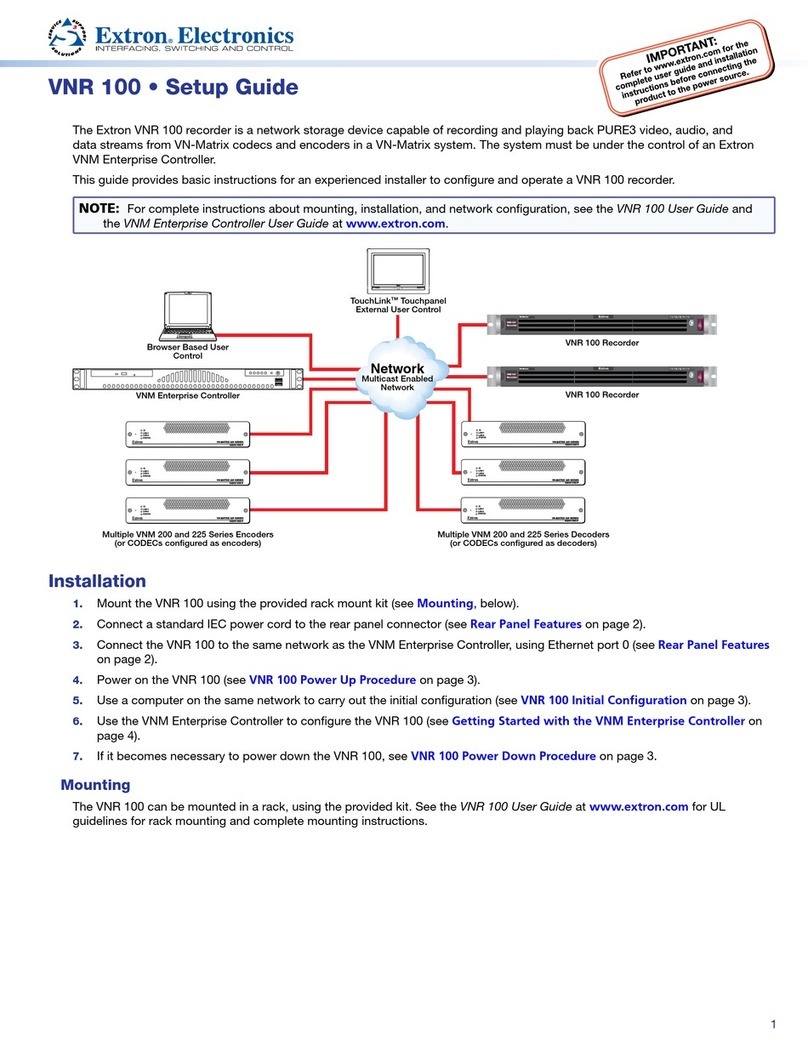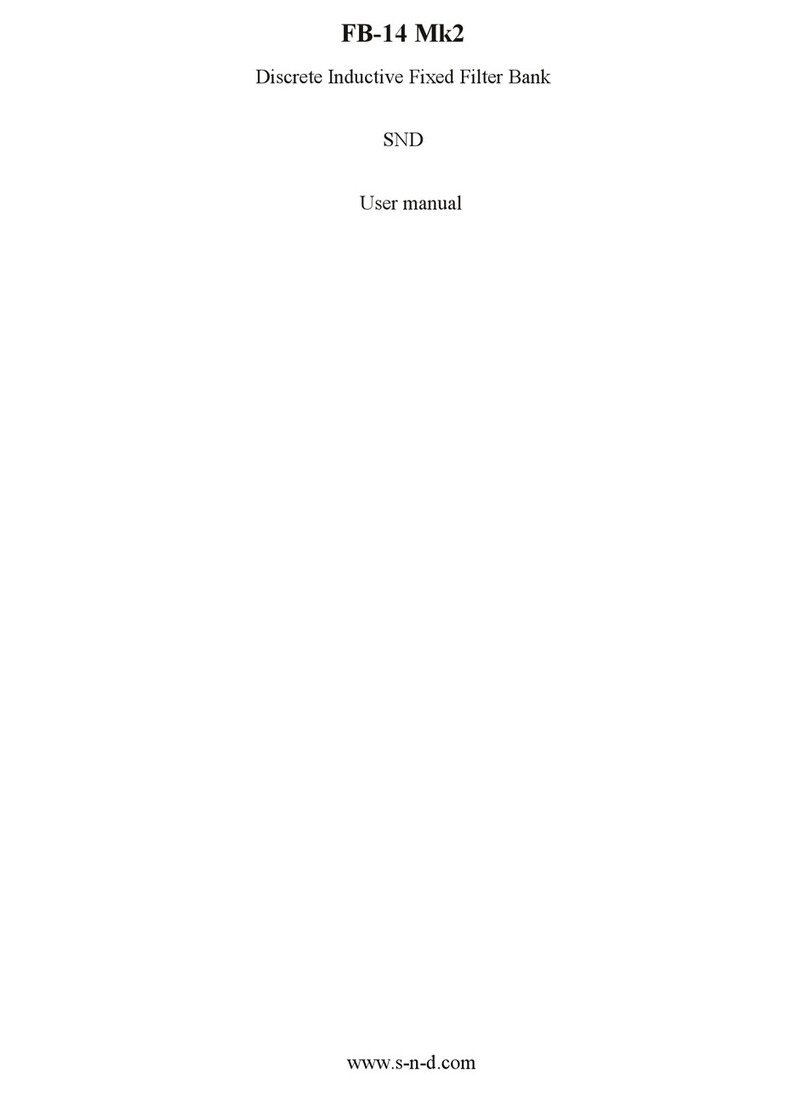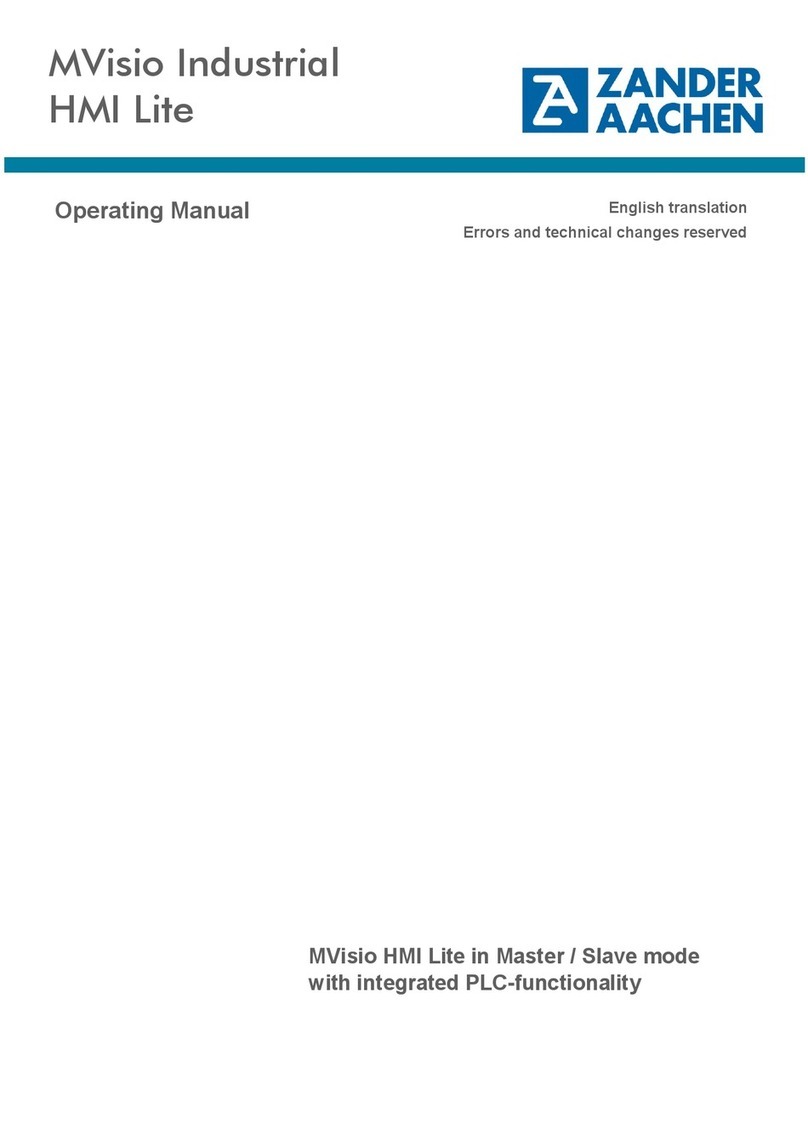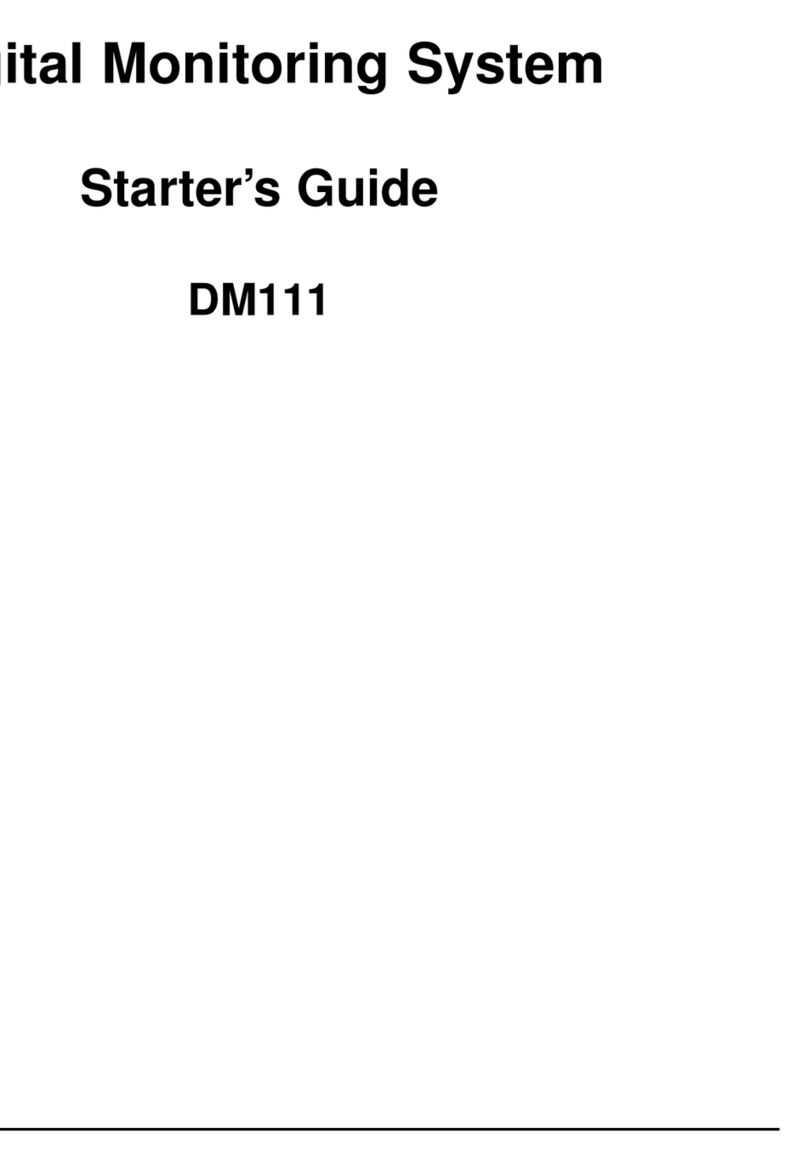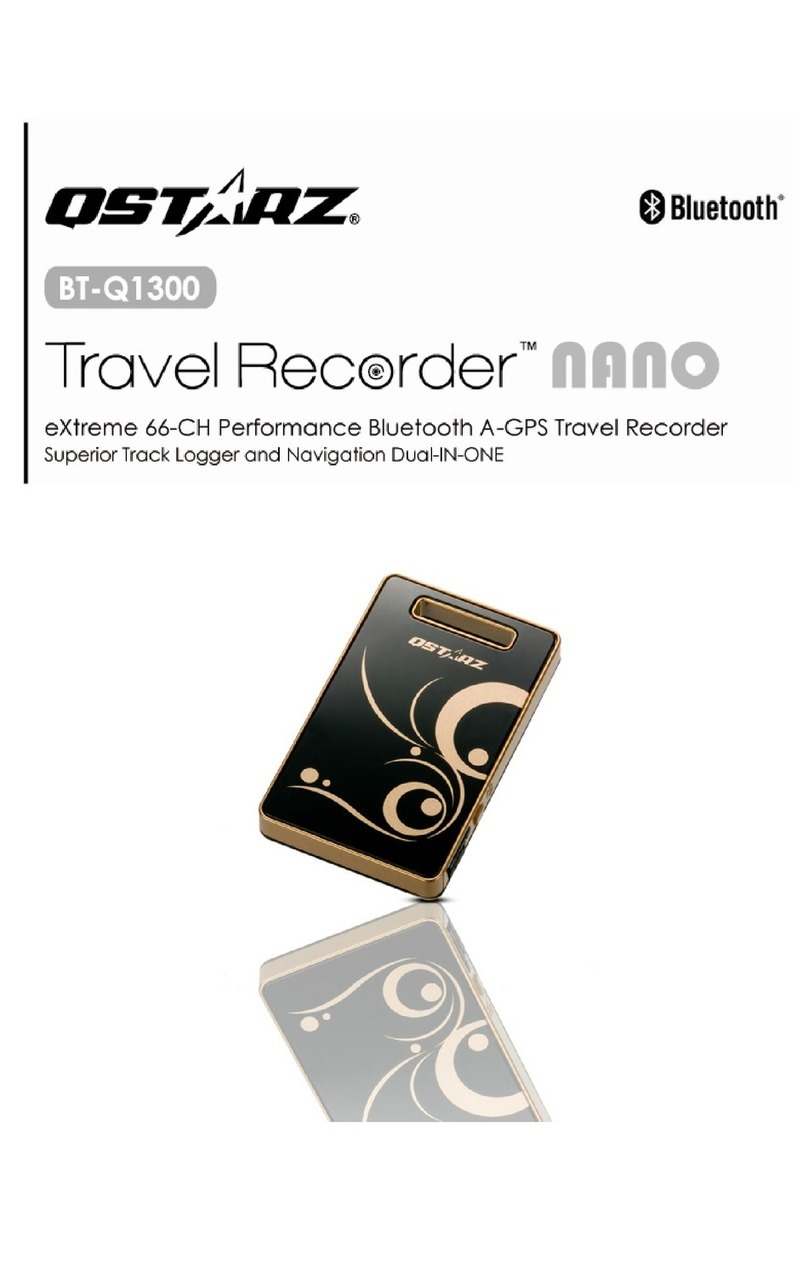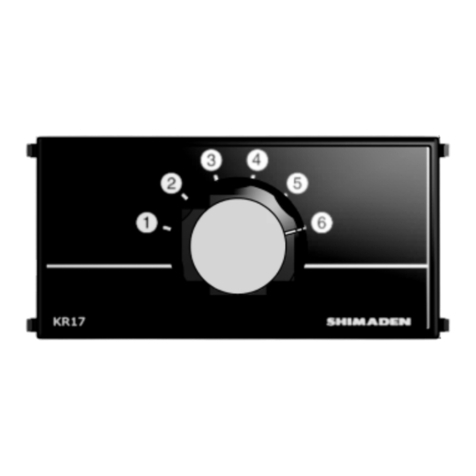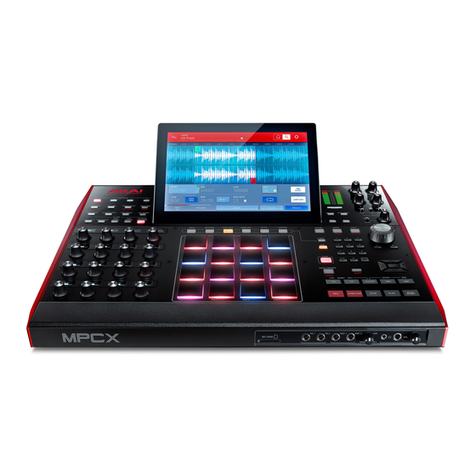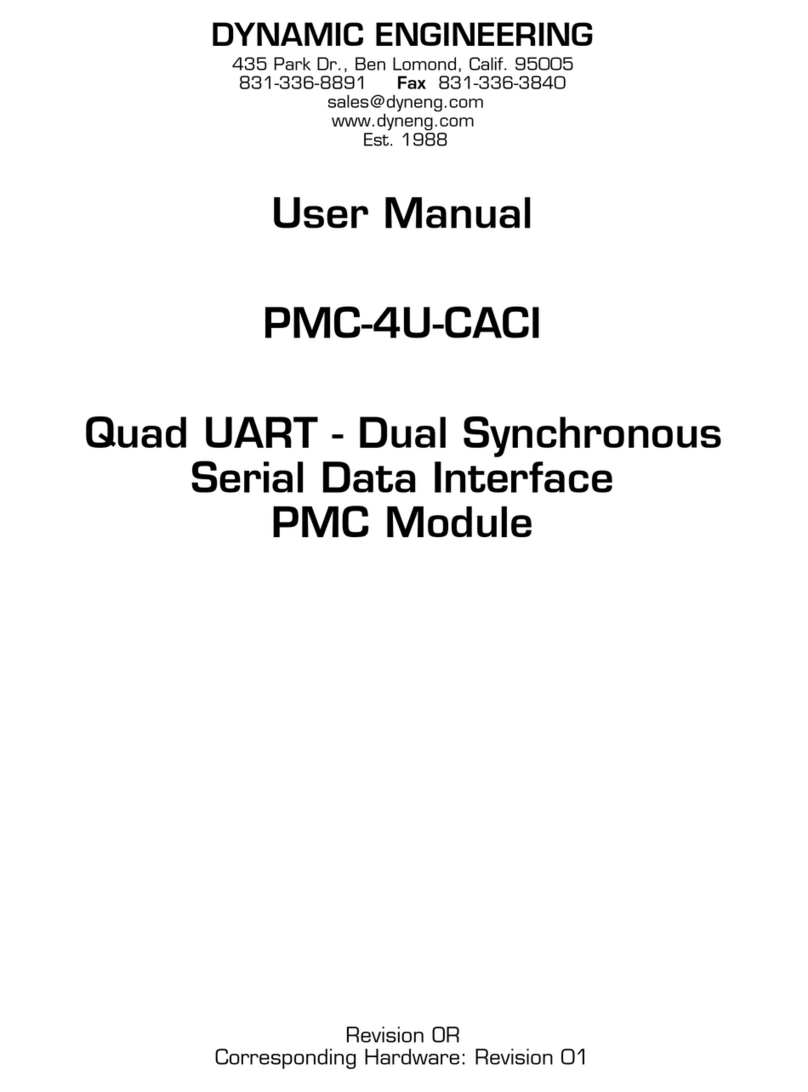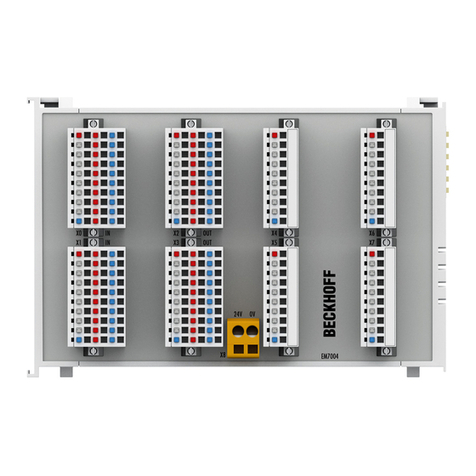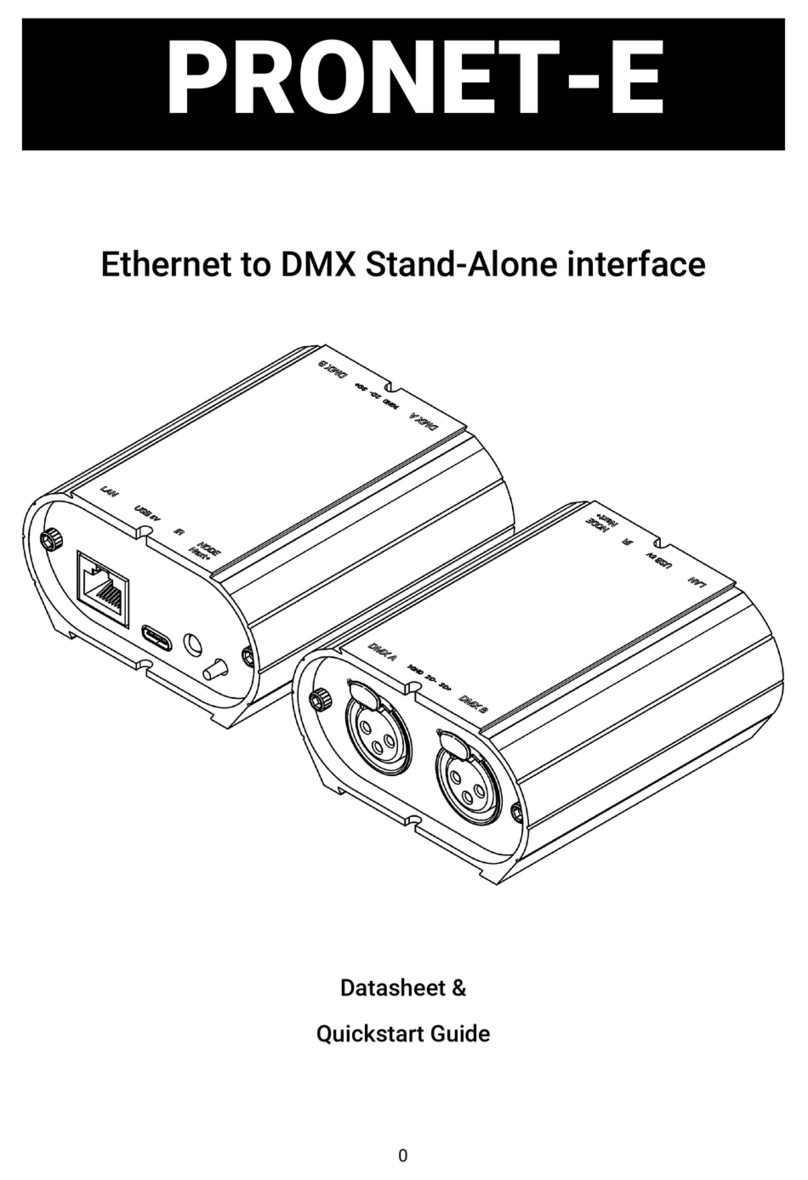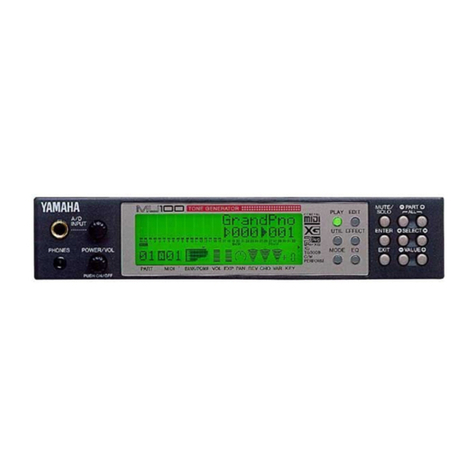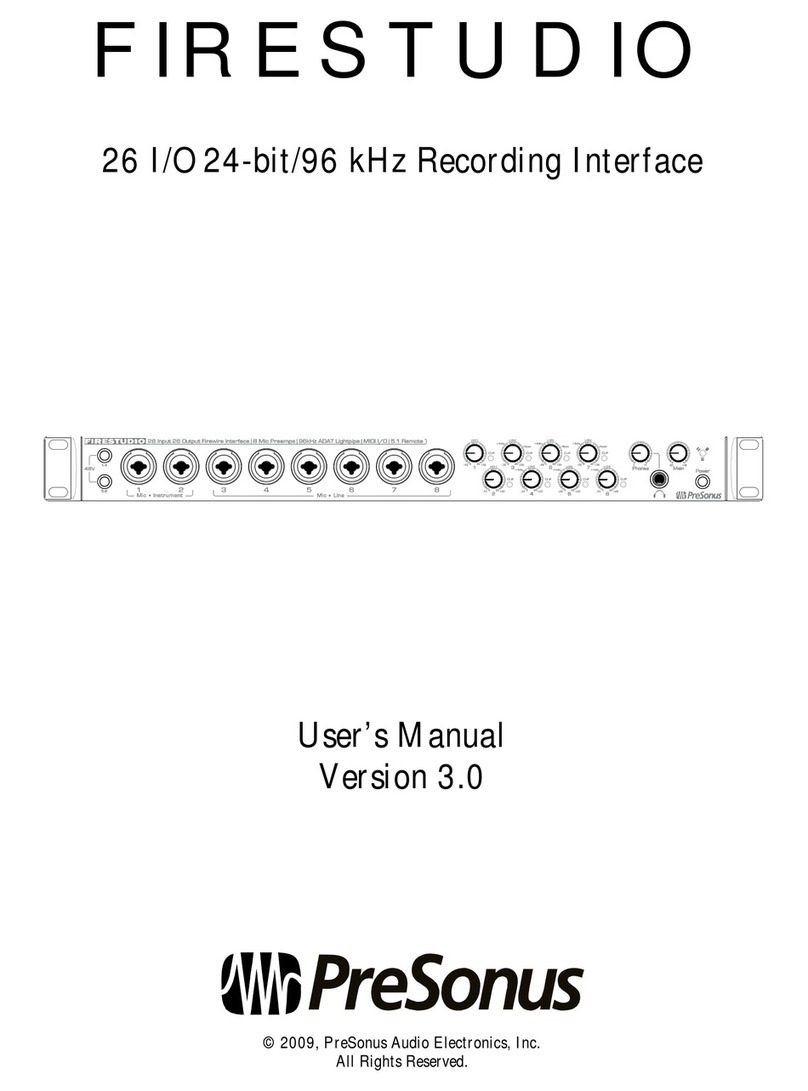Vitec Multimedia RLY-6 User manual

RELAY INTERFACE
INSTRUCTION MANUAL
RLY-6

RLY-6 Relay Interface Instruction Manual
©1997, 2005 Vitec Group Communications, Inc.
All Rights Reserved
Part Number 810310, Rev. A
Vitec Group Communications, Inc.
4065 Hollis Street
Emeryville, CA 94608-3505
U.S.A
Clear-Com is a registered trademark of Vitec Group Communications, Inc.
The Clear-Com Logo is a registered trademark of Vitec Group Communications, Inc.
Eclipse is a registered trademark of Vitec Group Communications, Inc.

RLY-6 RELAY INTERFACE i
CONTENTS
IMPORTANT SAFETY INSTRUCTIONS ii-iii
OPERATION 1-1
Introduction . . . . . . . . . . . . . . . . . . . . . . . . . . . . . . . . . . . . . . . . . . . . . . . . . 1-1
Description . . . . . . . . . . . . . . . . . . . . . . . . . . . . . . . . . . . . . . . . . . . . . . . . . . 1-1
Operation . . . . . . . . . . . . . . . . . . . . . . . . . . . . . . . . . . . . . . . . . . . . . . . . . . . 1-1
Configuration . . . . . . . . . . . . . . . . . . . . . . . . . . . . . . . . . . . . . . . . . . . . . . . . 1-1
INSTALLATION 2-1
Introduction . . . . . . . . . . . . . . . . . . . . . . . . . . . . . . . . . . . . . . . . . . . . . . . . . 2-1
Description . . . . . . . . . . . . . . . . . . . . . . . . . . . . . . . . . . . . . . . . . . . . . . . . . . 2-1
Installation . . . . . . . . . . . . . . . . . . . . . . . . . . . . . . . . . . . . . . . . . . . . . . . . . . 2-2
Wiring. . . . . . . . . . . . . . . . . . . . . . . . . . . . . . . . . . . . . . . . . . . . . . . . . . . . . . 2-2
To M a t r ix 2 - 2
To E x t e r n al D e v i c e 2 - 2
Configuration . . . . . . . . . . . . . . . . . . . . . . . . . . . . . . . . . . . . . . . . . . . . . . . . 2-4
SPECIFICATIONS 3-1
VITEC GROUP COMMUNICATIONS WARRANTY 4-1
Technical Support . . . . . . . . . . . . . . . . . . . . . . . . . . . . . . . . . . . . . . . . . . . . . 4-1
Exceptions. . . . . . . . . . . . . . . . . . . . . . . . . . . . . . . . . . . . . . . . . . . . . . . . . . . 4-1
Warranty Repairs. . . . . . . . . . . . . . . . . . . . . . . . . . . . . . . . . . . . . . . . . . . . . . 4-2
Non-Warranty Repairs. . . . . . . . . . . . . . . . . . . . . . . . . . . . . . . . . . . . . . . . . . 4-2

RLY-6 RELAY INTERFACE
ii

RLY-6 INTERFACE INSTRUCTION MANUAL iii
IMPORTANT SAFETY INSTRUCTIONS
Please read and follow these instructions before operating the RLY-6 general
purpose outputs interface. Keep these instructions for future reference.
(1) WARNING: To reduce the risk of fire or electric shock, do not expose this
apparatus to rain or moisture.
(2) Do not use the apparatus near water.
(3) Clean only with a dry cloth.
(4) Do not block any ventilation openings. Install in accordance with the
manufacturer’s instructions. Install the RLY-6 interface according to the
directions in the installation chapter of this manual.
(5) Do not install near any heat sources such as radiators, heat registers, stoves, or
other apparatus (including amplifiers) that produce heat. Do not place naked
flame sources such as candles on or near the matrix.
(6) Do not defeat the safety purpose of the polarized plug or grounding-type
plug. A polarized plug has two blades with one wider than the other. A
grounding-type plug has two blades and a third grounding prong. The wide
blade or the third prong are provided for your safety. If the provided plug does
not fit into your outlet, consult an electrician for replacement of the obsolete
outlet.
(7) Protect power leads from being walked on or pinched particularly at plugs, at
convenience receptacles, and at the point where they exit from the apparatus.
Note: A “convenience receptacle” is an extra AC power outlet located on the back
of a piece of equipment, intended to allow you to power other equipment.
(8) Only use attachments/accessories specified by the manufacturer.
(9) Use only with the cart, stand, tripod, bracket, or table specified by the
manufacturer, or sold with the apparatus. When a cart is used, use caution when
moving the cart/apparatus combination to avoid injury from tip-over.
(10) Unplug the apparatus during lightning storms or when unused for long
periods of time.
(11) Refer all servicing to qualified service personnel. Servicing is required when
the apparatus has been damaged in any way, such as a power-supply cord or plug
is damaged, liquid has been spilled or objects have fallen into the apparatus, the
apparatus has been exposed to rain or moisture, does not operate normally, or has
been dropped.
Please familiarize yourself with the safety symbols in Figure 1. When you see
these symbols on an Eclipse matrix system, they warn you of the potential danger
of electric shock if the system is used improperly. They also refer you to
important operating and maintenance instructions in the manual.
Please read and follow these
instructions before operating
the RLY-6 general purpose
outputs interface.

RLY-6 INTERFACE INSTRUCTION MANUAL
iv
Figure 1: Safety Symbols
CAUTION
RISK OF ELECTRIC SHOCK
DO NOT OPEN
This symbol alerts you to the presence of uninsulated dangerous
voltage within the product's enclosure that might be of sufficient
magnitude to constitute a risk of electric shock. Do not open
the product's case.
This symbol informs you that important operating and main-
tenance instructions are included in the literature accompanying
this product.

RLY-6 RELAY INTERFACE 1-1
OPERATION
INTRODUCTION
This chapter describes how to configure and use the RLY-6 relay interface
module. System operators can use this manual once the Eclipse System has been
correctly installed and the relays have been assigned with the Eclipse
Configuration System.
DESCRIPTION
The RLY-6 provides six independent single-pole, double-throw (SPDT) relays
that are directly controlled by the CPU card in the matrix frame. Like the GPI-6,
this interface connects to the matrix through the separate RJ-45 accessory data
connector on the matrix frame.
The Eclipse system supports up to 10 GPI-6 interfaces, for a total of 60 outputs.
You can use a mix of GPI-6 and RLY-6 interfaces to support up to a total of 60
outputs and/or inputs. For example, five RLY-6 and five GPI-6 modules would
provide 30 relays and 30 inputs for a total of 60 inputs/outputs.
All of the RLY-6 and GPI-6 interfaces in the system are daisy-chained from the
GPI/RLY connection on the matrix. The matrix system will automatically
identify both the type and "address" of every relay output or logic input.
The front panel of the RLY-6 has six green LEDs to indicate the operation of
each of the relays in the module. A seventh yellow LED indicates that the module
is communicating with the CPU card in the frame. There is also a TEST
pushbutton switch for each relay to allow local activation of a relay for test of
hardware connected to the relay contacts.
The RLY-6 interface module provides the following functions:
• Six independent sets of relay contacts which are activated from the matrix.
• DC isolation between relay device(s) and the central matrix.
• An LED indicator for each relay that lights when the relay is active.
Each RLY-6 interface relay contact is a single-throw double-pole pair for use by
the user. They are rated at 1 ampere at 24 volts DC (resistive load). The RLY-6 is
not designed for switching mains AC line voltage. To switch an external device
that runs on the mains AC line voltage, use an external relay that is activated by
the RLY-6.
The RLY-6 interface contains circuitry to ensure that relays are not inadvertently
activated during power-up until commanded by the matrix.
Logical control of the relays in the RLY-6 interface is provided by associating a
relay with any other label in the system using the Eclipse Configuration System
programming software. Activating a TALK or LISTEN label with a relay
The GPI-6 relay interface
module provides six
independent, single-pole,
double-throw (SPDT) relays
that are directly controlled
by the matrix.
General purpose outputs are
also called “relays.”
1

RLY-6 RELAY INTERFACE
1-2
associated to it will also activate that relay. There is a special classification of
labels for relays called Control Labels.
A TEST pushbutton switch is provided for each relay to allow local activation of
the relay for hardware testing purposes.
OPERATION
Once the RLY-6 is installed and configured there are no controls for day-to-day
operation. Operation of each individual relay is indicated by LEDs.
The TEST switches for each relay can be used to operate a given relay to test that
connection.
The yellow LED should be 'on' all of the time indicating that the frame is
communicating with the module.
CONFIGURATION
Control of these relays is accomplished by using the Eclipse Configuration
System programming software. Refer to the Eclipse Configuration System Manual
for more information.

RLY-6 RELAY INTERFACE 2-1
INSTALLATION
INTRODUCTION
This chapter describes the installation of the RLY-6 relay interface module and
wiring to the external devices. The RLY-6 occupies one slot in an interface frame.
Connections are made to the matrix frame via an 8-pin RJ-45 connector, and to
the external devices via two DB-9M connectors. There are no adjustment
controls for the RLY-6.
INSTALLATION
To install the RLY-6 interface module in the IMF-3 or IMF-102 interface frame,
select a slot to install the interface in.
1. Remove the blank plates from the front and rear of the slot in which an
interface module will be installed.
2. Install the interface module in the appropriate slot. Advance the front half the
interface module along the guides in the front part of the slot until it connects
to the midplane connector. Advance the rear half of the interface module
along the guides in the rear part of the slot, until it connects with the
midplane connector.
3. Install the provided screws on the front and rear panels of the interface module
you have just installed, to secure the interface in place in the frame.
The rest of the installation consists of connecting the RLY-6 module to the
control input and to the matrix frame (or to the “daisy-chain” output of another
RLY-6 or GPI-6 interface module).
For more information on installing the RLY-6 interface in an IMF-3 or IMF-102
interface frame, see the Interface Module Frames Instruction Manual.
WIRING
The following sections describe connecting the RLY-6 to the matrix and external
devices.
TO MATRIX
To connect the RLY-6 to the matrix, plug one end of a RJ-45 cable (eight wires
with no reversal) into the GPI-RLY INTERFACE connector on the back of the
matrix. Plug the other end into the top RJ-45 (CH. A MATRIX) connector for
the RLY-6.
To connect an additional RLY-6 interface, plug one end of a short RJ-45 cable
into the lower RJ-45 (CH. B MATRIX) for the first RLY-6. Then, plug the other
end into the top RJ-45 (CH. A MATRIX) connector additional RLY-6. (See
Figure 1 on the next page.) Additional RLY-6 interfaces are added in the same
2

RLY-6 RELAY INTERFACE
2-2
way, using "daisy-chain" wiring. If there are multiple RLY-6 modules, the relays
in the first module are numbered 1 to 6; the relays in the second module are
numbered 7 to 12, etc. GPI-6 modules can be mixed in this 'daisy-chained'
scheme. The maximum combined length of all the RJ-45 cables should not
exceed 20 feet (6 meters).
TO EXTERNAL DEVICE
To connect external devices to the RLY-6 interface, use the two DB-9M
connectors on the rear cable assembly panel for the interface. Figure 2 shows the
pin assignment of these connectors as viewed from the frame side of the
connector.
If a DB-9F is plugged into the connector labeled CH. A I/O, relays 1-3 are
available on that connector. The connector labeled CH.A I/O has the contacts
for relays 4-6. In the Figure 2, the labels on the pins apply to either connector.
Example: #1/4 COM refers to the wiper of relay 1 if it is connected to CH. A
and the wiper of relay 4 if it is connected to CH. B.
Figure 1: “Daisy-Chaining” RLY-6 Modules
Ports
Rear View of IMF-3 Frame
GPI/RLY
Interface
Connector
RJ-45 RJ-45 RJ-45 RJ-45 RJ-45
DB-9 DB-9 DB-9 DB-9 DB-9
RJ-45 RJ-45 RJ-45 RJ-45 RJ-45
DB-9 DB-9 DB-9 DB-9 DB-9
Other
Interfaces
GPI-6
#2
RLY-6
#2
R LY- 6
#1
GPI-6
#1

RLY-6 RELAY INTERFACE 2-3
Figure 2: RLY-6 Interface DB-9M Connector Pinout
CONFIGURATION
To associate a relay to a label, use the Eclipse Configuration System (ECS)
programming software, as described in its manual.
1
2
9
8
7
6
5
4
3
#1/4 Normally Open
#2/5 COM
#3/6 Normally Open
#1/4 Normally Closed
#1/4 COM
#2/5 Normally Closed
#2/5 Normally Open
#3/6 Normally Closed
#3/6 COM

RLY-6 RELAY INTERFACE
2-4

RLY-6 RELAY INTERFACE 3-1
SPECIFICATIONS
RelayType 1 Form C
Quantity 6
Contact Max. Volts 24 volts DC
Contact Max. Cur. 1 ampere continuous,
(2 amperes peak at 24 volts DC (resistive load)
DC Isolation 10 mega-ohms
Module Power Supply Requirements
Voltage Required 8 – 10 volts DC
Current Required 150 mA max (25 mA per relay when active)
Connectors
Relay Contacts 2 ea. DB-9M
Matrix Connection 2 ea. RJ-45 each
Indicators and Controls
LED Indicators 6 Green (1 ea. per relay)
1 Yellow (Frame Data)
Pushbutton Switches 6 (1 Test Pushbutton per relay)
Wiring Requirements
Maximum line lengths for connection to Matrix Frame
Matrix Frame to interface frame shall be less than 15 feet ( 5 meters)
Maximum line length between interface frame inputs 6 inches (15 cm)
Operating Environment
Temperature 0 and 70° C (32 -150° F)
Package Dimensions
Height 5 1/16" (129 mm)
Width 1 3/8" (35 mm)
Depth 9 5/32" (233 mm)
Weight .35 LBS (.15 kg)
Notice About Specifications
While Vitec Group Communications makes every attempt to maintain the
accuracy of the information contained in its product manuals, that information
is subject to change without notice. Performance specifications included in this
manual are design-center specifications and are included for customer guidance
and to facilitate system installation. Actual operating performance may vary.
3

RLY-6 RELAY INTERFACE
3-2

VITEC GROUP COMMUNICATIONS WARRANTY 4-1
VITEC GROUP COMMUNICATIONS
WARRANTY
Vitec Group Communications (VGC) guarantees this product to be free of
manufacturing defects in material and workmanship under normal use for a
period of two years from the date of purchase.
TECHNICAL SUPPORT
To ensure complete and timely support to its customers, VGC maintains
Technical Service Centers (TSC) staffed by qualified technical personnel. A
Technical Service Center is staffed to respond to all technical inquiries and to
troubleshoot technical problems regarding all products supplied by VGC. A TSC
is fully available to VGC’s customers during the full course of their warranty period.
Instructions for reaching our Technical Service Centers are given below.
For technical support from Europe, the Middle East, and Africa
Call: +49 40 66 88 40 40 Monday through Friday 09:00 – 17:00 (GMT)
+49 40 66 88 40 41 24hrs, any day (But you must have your PIN number
ready.)
Web site: www.clearcom.com (Click the 24 X 7 User Support symbol on the
Web site.)
For technical support from the Americas and Asia
Call: +1 510 496 6666 or 800 VITEC USA
Web site: www.clearcom.com (Click the 24 X 7 User Support symbol on the
Web site.)
FAX: +1 510 496 6610
EXCEPTIONS
This warranty does not include damage to a product resulting from cause other
than part defect and malfunction. The VGC warranty does not cover any defect,
malfunction, or failure caused beyond the control of VGC, including
unreasonable or negligent operation, abuse, accident, failure to follow
instructions in the manual, defective or improperly associated equipment,
attempts at modification and repair not approved by VGC, and shipping
damage. Products with their serial numbers removed or defaced are not covered
by this warranty.
Clear-Com offers 24/7
customer support.
Return authorization
numbers are required for all
returns.
Both warranty and
non-warranty repairs are
available.
4

VITEC GROUP COMMUNICATIONS WARRANTY 4-2
WARRANTY REPAIRS
While VGC will ensure complete system integrity by providing whatever support
is necessary to resolve any failure covered under the terms of the warranty, the
normal procedure will be to repair or replace any defective Line Replaceable Unit
(LRU) that is returned to VGC during the warranty period.
A Line Replaceable Unit (LRU) is defined as: an assembly that can be safely
removed from the system and readily replaced by plugging in a new unit. In the
case of ancillary items such as power supplies, the entire power supply would be
returned. Whereas, in the case of circuit cards, control panels, etc., only these
assemblies would be returned for repair. All equipment provided by VGC is
covered under the warranty.
This warranty does not include defects arising from installation (when not
performed by VGC), lightning, power outages and fluctuations, air conditioning
failure, improper integration with non-approved components, defects or failures
of customer furnished components resulting in damage to VGC provided
product.
NON-WARRANTY REPAIRS
Equipment that is not under warranty must be sent prepaid to VGC. If
requested, an estimate of repair costs will be issued prior to service. Once repair is
approved and completed, the equipment will be shipped freight collect from the
TSC.
REPLACEMENT UNITS
Should VGC determine, in its reasonable discretion, that any part of a product is
defective due to faulty materials or workmanship, VGC shall at its expense,
repair or replace such part and return the repaired/replacement part to the
customer. The provisions of this warranty shall apply to the repaired/replacement
part for the unexpired portion, if any, of the warranty period.
EMERGENCY ON-SITE ASSISTANCE
VGC can provide emergency on-site technical assistance in support of warranty
activities. The level of support effort required will be decided on a case-by-case
basis. VGC has the qualified technical staff to support any and all emergency site
activities should they occur.
LIABILITY
The foregoing warranty is VGC’s sole and exclusive warranty. There are no other
warranties (including without limitation warranties for consumables and other
supplies), or guarantees, expressed or implied (including, without limitation, any
warranties of merchantability or fitness for a particular purpose), of any nature
whatsoever, whether arising in contract, tort, negligence of any degree, strict
liability or otherwise, with respect to the products or any part thereof delivered

VITEC GROUP COMMUNICATIONS WARRANTY 4-3
hereunder and/or with respect to any non-conformance or defect in any such
product and/or part thereof delivered hereunder and/or with respect to any
non-conformance or defect in any such product and/or part thereof delivered
hereunder, or any other warranties or guarantees, including but not limited to
any liability of VGC for any consequential and/or incidental damages and/or
losses (including loss of use, revenue, and/or profits). In any event, the maximum
extent of VGC’s liability to customer hereunder shall not under any
circumstances exceed the cost of repairing or replacing any part(s) fount to be
defective within the warranty period as aforesaid.
RETURNING EQUIPMENT FOR REPAIR
All equipment returned for repair must be accompanied by:
• Documentation stating the return address, telephone number, date of
purchase, and a description of the problem.
• A repair reference number.
To obtain a repair reference number, contact the appropriate Technical Service
Center at the phone numbers or Web sites listed below. Our representatives will
give you instructions and addresses for returning your equipment. By talking
with our representatives, many problems can be resolved on the phone.
For returns from Europe, the Middle East, and Africa
Call: +49 40 66 88 40 40 Monday through Friday 09:00 – 17:00 (GMT)
+49 40 66 88 40 41 anytime, any day
(But you must have your PIN number ready)
Web site: www.clearcom.com (Click the 24 X 7 User Support symbol on the
Web site.)
For returns from the Americas and Asia
Call: +1 510 496 6666 or 800 VITEC USA
Web site: www.clearcom.com (Click the 24 X 7 User Support symbol on the
Web site.)
Email: [email protected]
FAX: +1 510 496 6610

VITEC GROUP COMMUNICATIONS WARRANTY 4-4
WARRANTY VALIDATION
To validate your warranty, fill in the information below, and mail it to your local
Technical Service Center.
Table of contents
Other Vitec Multimedia Recording Equipment manuals

